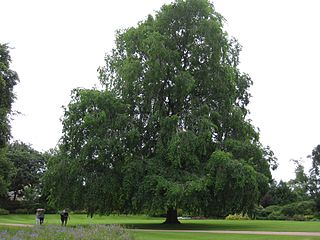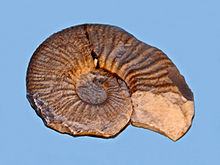
Ulmus 'Exoniensis', the Exeter elm, was discovered near Exeter, England, in 1826, and propagated by the Ford & Please nursery in that city. Traditionally believed to be a cultivar of the Wych Elm U. glabra, its fastigiate shape when young, upward-curving tracery, small samarae and leaves, late leaf-flush and late leaf-fall, taken with its south-west England provenance, suggest a link with the Cornish Elm, which shares these characteristics.

The Field Elm cultivar Ulmus minor 'Viminalis Aurea', probably a "golden" form of Ulmus minor 'Viminalis', was raised before 1866 by Egide Rosseels of Louvain, who was known to have supplied 'Viminalis'.

The elm cultivar Ulmus 'Berardii', Berard's Elm, was raised in 1865, as Ulmus Berardi, from seeds collected from large specimens of "common elm" growing on the ramparts at Metz, by an employee of the Simon-Louis nursery named Bérard. Carrière (1887), the Späth nursery of Berlin and the Van Houtte nursery of Gentbrugge regarded it as form of a Field Elm, listing it as U. campestris Berardii, the name used by Henry. Cheal's nursery of Crawley distributed it as Ulmus nitens [:Ulmus minor] 'Berardii'. Smith's of Worcester preferred the original, non-specific name, Ulmus 'Berardii'.
The Elm cultivar Ulmus 'Tiliaefolia' was first mentioned by Host in Flora Austriaca (1827), as Ulmus tiliaefolia [:linden-leaved]. The Späth nursery of Berlin distributed a 'Tiliaefolia' from the late 19th century to the 1930s as neither an U. montana hybrid nor a field elm cultivar, but simply as Ulmus tiliaefolia, suggesting uncertainty about its status. Herbarium specimens appear to show two clones, one smaller-leaved and classified as a field elm cultivar, the other larger-leaved.
The elm cultivar Ulmus 'Folia Rubra' was listed as Ulmus campestris foliis rubris by Louis de Smet in his catalogue of 1877, and Edouard Pynaert van Geert in the same year who obtained the tree from M. Gaujard of Wetteren, Belgium. An U. campestris fol. rubrisHort. was distributed by the Späth nursery, Berlin, in the 1890s and early 1900s.

Ulmus × hollandica 'Klemmer', or Flanders Elm, is probably one of a number of hybrids arising from the crossing of Wych Elm with a variety of Field Elm, making it a variety of Ulmus × hollandica. Originating in the Bruges area, it was described by Gillekens in 1891 as l'orme champêtre des Flandres in a paper which noted its local name, klemmer, and its rapid growth in an 1878–91 trial. Kew, Henry (1913), and Krüssmann (1976) listed it as an Ulmus × hollandica cultivar, though Henry noted its "similarity in some respects" to field elm Ulmus minor, while Green went as far as to regard it as "possibly U. carpinifolia" (:minor).
The hybrid elm cultivar Ulmus × hollandica 'Modiolina', or Wheel-hub elm, was probably the large-leaved 'Orme tortillard' first described by Duhamel in De l'exploitation des bois (1764). Poederlé (1774) identified the tree as the 'orme maigre' growing in the region that later became part of Belgium. Dumont de Courset described a small-leaved U. campestris var. modiolina, "l'orme tortillard" in 1802 – the first use of the name 'Modiolina'. 'L'orme Tortillard', also known as 'l'orme à moyeux', was considered in France to be the best elm for use by wheelwrights, its timber especially suitable for hubs of wheels. Van Houtte marketed an U. campestris modiolina (tortuosa), and Späth an U. campestris modiolina, from the late 19th century. U. campestris var. modiolinaHort was confirmed as a hybrid by Chevalier in Les Ormes de France (1942) and called U. × 'Modiolina', 'l'orme à moyeux'.
Balearites is an extinct ancyloceratin genus included in the family Crioceratitidae, subclass Ammonoidea, from the Upper Hauterivian.
Haploceratoidea, formerly Haplocerataceae, is an extinct superfamily of ammonoid cephalopods belonging to the Ammonitida that unites three families, Strigoceratidae, Oppeliidae, and Haploceratidae, listed below.
Ancyloceratoidea, formerly Ancylocerataceae, is a superfamily of typically uncoiled and loosely coiled heteromorph ammonoids established by Alpheus Hyatt in 1900, that may contain as many as 11 families, depending on the classification accepted.
Heminautilus is an extinct genus of nautiloids from the nautilacean family Cenoceratidae that lived during the Early Cretaceous. Fossils of Heminautilus have been registered in rocks of Barremian and Aptian age. Nautiloids are a subclass of shelled cephalopods that were once diverse and numerous but are now represented by only a handful of species.

Ulmus × hollandica 'Wentworthii Pendula', commonly known as the Wentworth Elm or Wentworth Weeping Elm, is a cultivar with a distinctive weeping habit that appears to have been introduced to cultivation towards the end of the 19th century. The tree is not mentioned in either Elwes and Henry's or Bean's classic works on British trees. The earliest known references are Dutch and German, the first by de Vos in Handboek tot de praktische kennis der voornaamste boomen (1890). At about the same time, the tree was offered for sale by the Späth nursery of Berlin as Ulmus Wentworthi pendulaHort.. The 'Hort.' in Späth's 1890 catalogue, without his customary label "new", confirms that the tree was by then in nurseries as a horticultural elm. De Vos, writing in 1889, states that the Supplement to Volume 1 includes entries announced since the main volume in 1887, putting the date of introduction between 1887 and 1889.

Stoycho Vassilev Breskovski was a Bulgarian paleontologist.

Ancyloceratidae is a family of heteromorphic ammonites that lived during the Early Cretaceous. Their shells begin as a loose spiral with whorls not touching which then turns into a straight shaft that ends in a J-shape hook or bend at end. Coarse ribbing and spines are common.

Metec–Solarwatt p/b Mantel is a UCI Continental team founded in 2012 and based in the Netherlands. It participates in UCI Continental Circuits races.

The Field Elm cultivar Ulmus minor 'Monumentalis', the tomb elm (Grabmal-Rüster), was raised as a sucker of U. suberosa by Sebastian Rinz, the city gardener of Frankfurt, before 1855 and listed by the Jacob-Makoy nursery of Liège in their 1861 catalogue as Ulmus monumentalisRinz, "a new variety". Kirchner (1864) described it, confirming that it had only recently been propagated by Rinz and established in the nursery. It was distributed from the 1880s by the Baudriller nursery, Angers, and by the Späth nursery, Berlin, as U. campestris monumentalisRinz., appearing separately in their catalogues from U. minor 'Sarniensis', the Guernsey or Wheatley Elm, with which, according to Henry, it was confused on the continent. Krüssmann, for example, gives 'Monumentalis' as a synonym of 'Sarniensis'. 'Sarniensis' is known as monumentaaliep [:monumental elm] in The Netherlands. Springer noted that the Dutch monumentaaliep was "not the actual monumentaaliep but U. glabraMill.var. Wheatleyi Sim. Louis", and that it "should be renamed U. glabraMill. var. monumentalisHort.(non Rinz)". In England, Smith's of Worcester listed Ulmus monumentalis separately from Ulmus 'Wheatley' in the 1880s.
The elm cultivar Ulmus 'Betulaefolia Nigrescens', the Black Birch-leaved Elm, reportedly a seedling of a purplish-leaved elm, was first described by Pynaert in 1879 as U. campestris betulaefolia nigrescens. An U. campestris betulaefolia nigrescensHort. was distributed by the Späth nursery, Berlin, in the 1890s and early 1900s.
Megacrioceratinae is an extinct ammonoid cephalopod subfamily. It has been described as family Megacrioceratidae in 2006, but later changed into subfamily under its current name. Ammonites belonging to this subfamily lived from Plesiospitidiscus ligatus zone of Upper Hauterivian until Avramidiscus kiliani zone of Lower Barremian.

The wych elm cultivar Ulmus glabraHuds. 'Superba', Blandford Elm, with unusually large leaves, was raised by Gill's of Blandford Forum, Dorset, in the early 1840s as Ulmus montana superba and was quickly distributed to other UK nurseries. It was confirmed as a form of wych, and first described, by Lindley in The Gardeners' Chronicle, 1845, later descriptions being added by Gill (1845) and Morren (1848), who called it U. montana var. superba. Morren had adopted the name 'Superba' from the Fulham nurseryman Osborne in 1844, who supplied him with the tree – presumably one of the nurseries supplied by Gill. Morren states that 'Superba', already in cultivation in England, was introduced to Belgium by Denis Henrard of Saint Walburge, Liège, that in 1848 it had been present in Belgium for only three years, and that this variety was the one described as 'Superba' by Osborne, whom Henrard had visited at his nursery in Fulham in September 1844. 'Blandford Elm', with leaves of the same dimensions, was soon for sale in the USA.

The Une Formation is a geological formation of the Altiplano Cundiboyacense, Eastern Ranges of the Colombian Andes. The predominantly sandstone formation dates to the Middle Cretaceous period; Albian to Cenomanian epochs and has a maximum thickness of 1,100 metres (3,600 ft).











